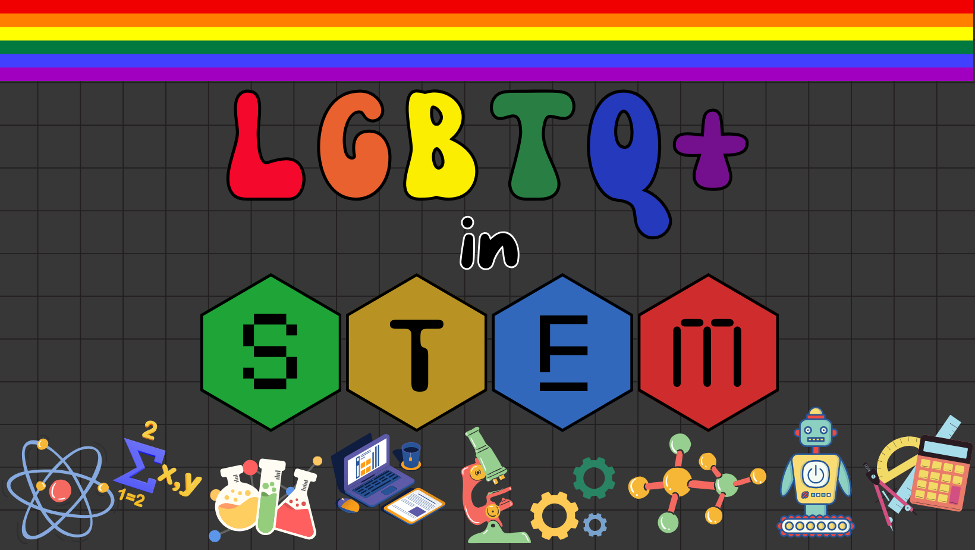
Every year, during the first week of April, the University of North Alabama celebrates Diversity Education Week (D.E.W.). This is a week dedicated to highlighting and celebrating the differences amongst everyone in the UNA campus community, as well as learning more about the history of diversity in education and advocating for the continued support of diverse students on college campuses. We are all unique and therefore have unique needs when it comes to college and beyond, and we all deserve to have an equal opportunity to pursue and achieve our goals! In honor of D.E.W., the Mitchell-West Center for Social Inclusion wants to highlight some of the influential LGBTQ+ figures, both past and present, who have broken through the societal boundaries placed against them to pursue careers in STEM fields while staying true to themselves.

2011: B.A. in Physics from Cornell College
2012: M.A. in Nuclear Physics from Stony Brook University
2017: Ph.D. in Heavy Ion Physics from Rutgers University
2017-2020: Post-doctoral Researcher at Wayne State University
2020-2022: Associate Research Scientist at Yale University and Brookhaven National Laboratory
Dr. Raghav Kunnawalkan Elayavalli is a non-binary, Indian physicist and professor at Vanderbilt University. Elayavalli came to the US in pursuit of higher education, choosing to focus their education on physics. Upon completion of their undergraduate education, they immediately continued into graduate studies, narrowing their focus to nuclear physics, specifically high-energy nuclear physics. Their master's thesis was in the form of a simulation package for the future Electron Ion Collider called EICROOT, where they studied the interaction of lepton-flavor violating processes. After doing their doctoral work with the CMS experiment at CERN, they moved their research back to RHIC science during their post-doctoral positions with the STAR collaboration. In their current position at Vanderbilt University in Nashville, TN, they teach undergraduate physics courses in quantum mechanics along with graduate-level seminars in various subcategories in physics. Elayavalli also supervises a group of students of varying classifications in a research setting, where they aim to chart the space-time evolution of fundamental particles such as quarks and gluons from their liberation during the moment of high-energy collision to their metamorphosis into hadrons. At the beginning of the pandemic in 2020, Elayavalli slowly began to be more open in their gender identity and expression, stating that they "do not associate with a single gender" and therefore prefer the use of they/them pronouns, but are equally as happy with she/her pronouns. They have also explained that they express themself to the world in a trans-feminine fashion in ways that people often assume that they are a transwoman, rather than non-binary. Elayavalli often wears traditionally feminine Indian garb to connect their gender expression and their heritage. Through their work at Vanderbilt University, they bring diversity into STEM fields like physics, as well as higher education as a whole.

2007: B.S. in Cardiovascular Science from the University of Auckland
2010: Ph.D. in Physiology from the University of Auckland
Dr. Izzy Jayasinghe is a Sri Lankan professor and researcher focusing on developing new optical microscopy techniques for studying the organization of the molecules of life, particularly proteins, within the heart. Jayasinghe was born in Sri Lanka but moved to Auckland, New Zealand, to study at the University of Auckland. She completed her undergraduate and doctoral studies there before focusing on postdoctoral fellowships at the University of Queensland as an Assistant Research Fellow from 2010-2011 and at the University of Exeter as a Post-Doctoral Research Fellow from 2011-2013. She built a track record in developing and applying new optical imaging methods during her postdoctoral fellowships, which led to her 2015 establishment of an independent research program at the University of Leeds. During her independent research program in Leeds, Jayasinghe developed adaptations of optical imaging methods such as DNA-PAINT and Expansion Microscopy to study pathological nanoscale remodeling in the failing heart. In 2018, Jayasinghe became a Fellow of the Higher Education Academy receiving accreditation as a higher education provider approved by the UK Professional Standards Framework. She is also a Fellow of the Royal Microscopical Society and advocates for Open Science and Equality and Inclusion in STEM. Jayasinghe currently serves as the Head of the Department of Molecular Medicine within the School of Biomedical Sciences at the University of New South Wales. Along with serving as Department Head, she also continues to focus on research on developing more accessible, faster, and higher resolution imaging methods for imaging optically thick (and biologically more complex) samples. Jayasinghe also has a passion for advocating for gender equality and diversity, equity, and inclusion in academia worldwide. Her strong advocacy in DEI initiatives can be seen in her work with organizations like TigerinSTEMM along with her keynote discussion at the 4th LGBT+ STEMinar in 2019.
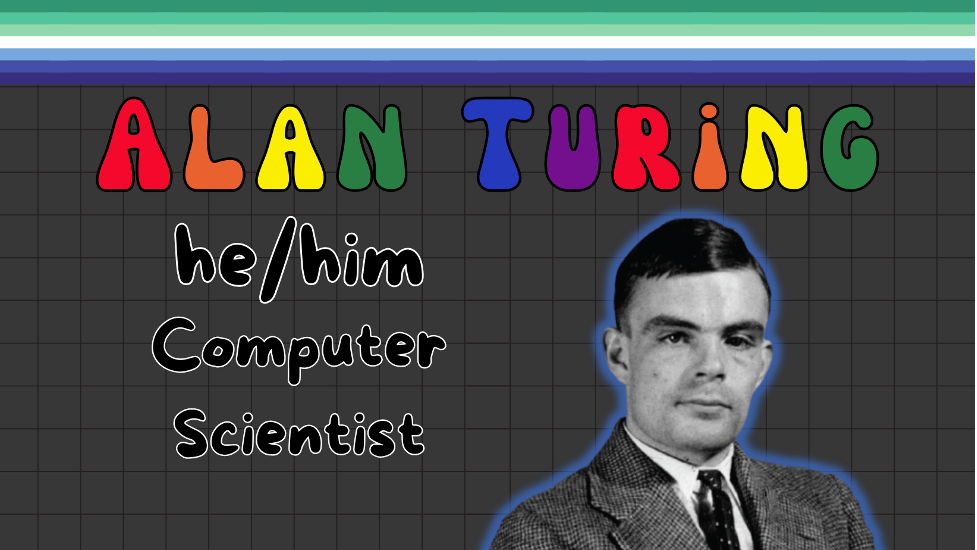
Circa 1934: B.A. in Mathematics from King’s College, Cambridge
Circa 1935: M.A. in Mathematics from King’s College, Cambridge
1938: Ph.D. in Mathematics from Princeton University
Dr. Alan Turing was an English mathematician and computer scientist known for his strong influence on the development of theoretical computer science with his formalization of algorithms and computation using the Turing Machine, and is widely considered to be the father of theoretical computer science and artificial intelligence. Born in London and raised in Southern England, Turing showed signs early in his childhood of the genius he would become. In his schooling, he showed a natural inclination towards mathematics and sciences and was able to solve advanced math problems at just 15 years old- before he studied basic calculus. At 16, Turing encountered the work of Albert Einstein and was not only able to understand it but was able to deduce that Einstein was questioning Newton’s laws of motion. During World War 2, Turing worked for the British Government at the Government Code and Cypher School, Britain’s code-breaking center. During his time there, he led a section, Hut 8, which was charged with German naval cryptanalysis. During this time, he devised several techniques used to speed up the process of breaking German ciphers, which played a crucial role in the Allies’ defeat of the Axis Powers in the Battle of the Atlantic. Post-war, Turing worked at the National Physical Laboratory, where he made the Automatic Computing Engine, one of the first stored-program computer designs. Despite these accomplishments, Turing was never fully recognized in Britain during his lifetime because much of his work was covered by the Official Secrets Act. In 1952, Turing was prosecuted for homosexual acts, a crime at the time called “gross indecency”. Turing pleaded guilty to the charges and accepted hormone treatment, also known as chemical castration, as an alternative to imprisonment. He died 2 years later of cyanide poisoning, and his death was ruled a suicide, though it is believed the poisoning was accidental rather than purposeful. Dr. Alan Turing is remembered as a genius in his fields of mathematics and computer science, as well as a hero in code-breaking during World War 2, but Turing was more than that; Dr. Alan Turing is one of the most notable cases of the criminalization of queerness.
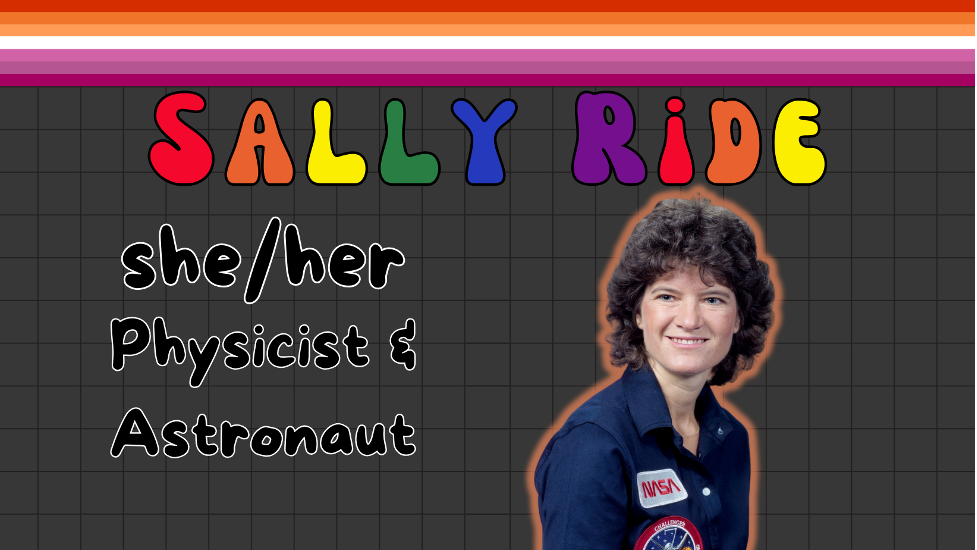
1973: B.S. in Physics from Stanford University
1973: B.A. in English Literature from Stanford University
1975: M.S. in Physics from Stanford University
1978: Ph.D. in Physics from Stanford University
Dr. Sally Ride, born in Los Angeles, California, was an American physicist and NASA astronaut known for being the youngest American astronaut to fly in space, as well as the first American woman to fly in space. During her youth, her family spent a year traveling across Europe, where Ride first played tennis, which she would continue to play through college. In 1978, Ride was selected to join the NASA Astronaut Group 8, the first group to include women, as a Mission Specialist Astronaut. After finishing her training, she served as the ground-based capsule communicator during the second and third Space Shuttle flights, as well as helped to develop the robotic arm used on the Shuttles. June 1983 saw Ride complete her first space flight aboard Challenger during the STS-7 mission, which deployed two communications satellites, along with the first Shuttle palette satellite, SPAS-1, with Ride operating the robotic arm. Her second space flight was in 1984, during the STS-41-G mission, also aboard Challenger. During her NASA years, Ride was married to fellow Group 8 astronaut Steven Hawley, but the two divorced in 1987, the same year Ride left NASA. After her time at NASA, she worked for 2 years at Stanford University’s Center for International Security and Arms Center, then worked at the University of California, San Diego, while conducting research. Ride is the only person to have served on both committees in charge of investigating the loss of the Space Shuttles Challenger and Columbia. Towards the end of her marriage with Hawley, Ride began her 27-year-long relationship with Women’s Tennis player Tam O’Shaughnessy. The two founded the nonprofit Sally Ride Science at UC San Diego to help inspire future generations through STEM. Ride spoke at the National Science Teacher’s Association Conference in 2011, during which O’Shaughnessy and a friend noticed that she looked ill. Upon seeking medical care, it was discovered that Ride had pancreatic cancer, after which Ride promised her estate to O’Shaughnessy and the two secretly registered their domestic partnership on August 15, 2011. Despite undergoing chemotherapy and surgery, Ride passed away in July 2012. When asked why the couple was not public with their relationship, O’Shaughnessy stated that Ride was worried that her identity would prevent her from getting jobs and funding for any future projects. Despite her worries, Ride is recognized as one of the most influential women in NASA history, as well as being the first known queer astronaut.
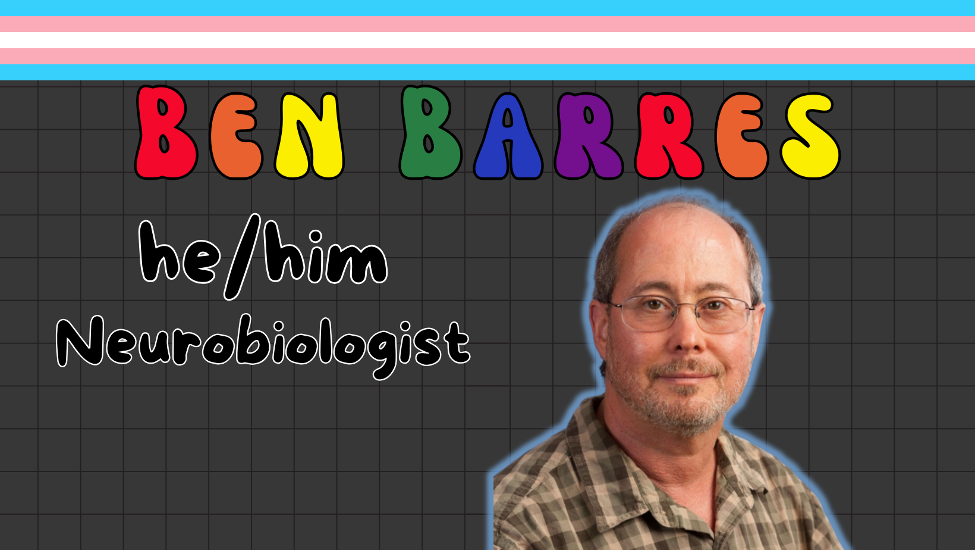
1976: B.S. in Biology from MIT
1979: M.D. from Dartmouth Medical School
1980: Uncompleted residency at Weill Cornell Medicine
1990: Ph.D. in Neurobiology from Harvard Medical School
1993: Post-doctoral training at University College London under Dr. Martin Raff
Dr. Ben Barres was an American neurobiologist from West Orange, New Jersey. Born a female, Barres struggled throughout childhood with his parents seeing him as simply being a “tomboy”, having said “Internally, I felt strongly that I was a boy. This was evident in my behavior.” Despite his struggles with identity during his childhood, he still managed to excel in mathematics and science at school and went on to pursue multiple degrees in biology and medicine. During his residency, Barres noted the lack of knowledge about the causes or cures of neurodegeneration. In studying pathology reports, he noticed a correlation between neural degeneration and irregular patterns of glial cells in the brain and resigned his residency to pursue further research on the topic at Harvard. In 1993, Barres joined the Neurobiology faculty at Stanford School of Medicine, where he continued to work on glial cell research. He spoke and wrote openly about being a trans man and his experiences transitioning in 1997. Barres also discussed his experiences with being treated differently as female versus male in the sciences. He noted that after his transition, many people who did not know him personally and did not know of his identity would treat him with much more respect than they would pre-transition. In 2008, Barres was appointed to the Chair of Neurobiology at Stanford and continued his research in a variety of areas. Barres was an inducted member of the Reeve Foundation International Research Consortium on Spinal Cord Injury, and in 2013 he was elected to the National Academy of Sciences, becoming the first openly transgender member. Barres passed away in December 2017, just 20 months after being diagnosed with pancreatic cancer. When asked if he felt content with his life he said “I lived life on my terms: I wanted to switch genders, and I did. I wanted to be a scientist, and I was. I wanted to study glia, and I did that too. I stood up for what I believed in and I like to think I made an impact, or at least opened the door for the impact to occur. I have zero regrets and I’m ready to die. I’ve truly had a great life.”
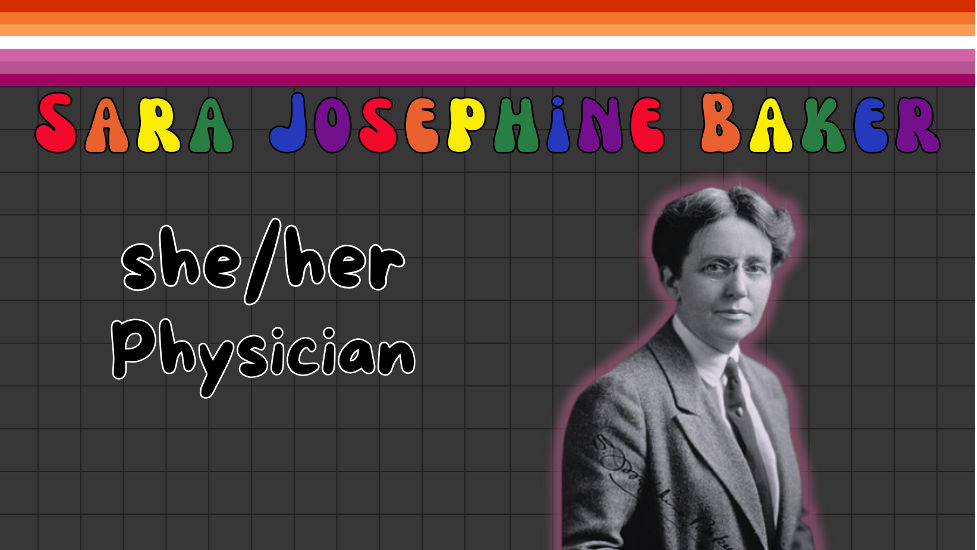
1898: M.D. from New York Infirmary Medical College
1900: Residency at New England Hospital for Women and Children
1917: Ph.D. in Public Health from New York University Medical School
Dr. Sara Josephine Baker, born in 1873 to a wealthy Quaker family, was an American physician known for her notable contributions to public health, focusing on immigrant communities in New York City, as well as her promotion of preventative medicine. Her father and brother both died of typhoid fever when she was only 16, leaving her to support her mother and sister financially, which led her to seek a career in medicine. Baker spent the next few years studying biology and chemistry at home while helping to care for her mother and sister and later graduated second in her class from an all-girls college. Following the completion of her residency in 1900, Baker began practicing as a private physician in New York City, and in 1901, she passed the civil service exam and became qualified to be a medical inspector at the Department of Health. Baker was offered an opportunity to help lower the mortality rate in Hell's Kitchen, and she decided to focus specifically on the infant mortality rate, as babies accounted for around 1,500 of the weekly deaths in the slum. Most of the infant deaths were caused by dysentery, though parental ignorance and poor hygiene were often indirectly to blame as well. Baker and a group of nurses started to train mothers in how to care for their babies by teaching them things like how to clothe babies properly, how to prevent suffocation, proper hygiene practices, and how to maintain a healthy diet for the baby. She also helped to set up a milk station, where clean and nutritious milk was handed out, as commercial milk at the time was often either cut with chalky water to maximize profits or was contaminated in some way, making it unhealthy for babies. Baker also went on to invent an infant formula to replace milk, which allowed mothers to hold jobs to help support their families financially. Early in her career, Baker also aided twice in catching "Typhoid Mary", the first known asymptomatic carrier of typhoid. Baker was becoming famous for her work, so much so that New York University Medical School asked her to lecture there on children's health. She agreed on the condition that she was allowed to enroll there herself, to which the school initially declined, but later accepted after being unable to find any male lecturer with her level of knowledge on the subject. In 1917 Baker became the first woman to receive a doctorate in public health. Baker continued working in other forms after retiring from practicing as a physician and became the first woman to be a professional representative to the League of Nations, serving on the Health Committee for the US from 1922 to 1924. She was also an active member of multiple medical societies and groups, including the New York State Department of Health, and later became the president of the American Medical Women's Association. Baker spent much of the later part of her life with Ida Alexa Ross Wylie, a novelist, and scriptwriter from Australia who identified as a "woman-oriented woman". After her retirement, Baker began running their household and worked on writing her autobiography Fighting for Life. Beyond this autobiography, little is known about Baker’s personal life, as is it speculated that she destroyed all of her personal writings and papers. On February 22, 1945, Baker passed away from a fight with cancer.
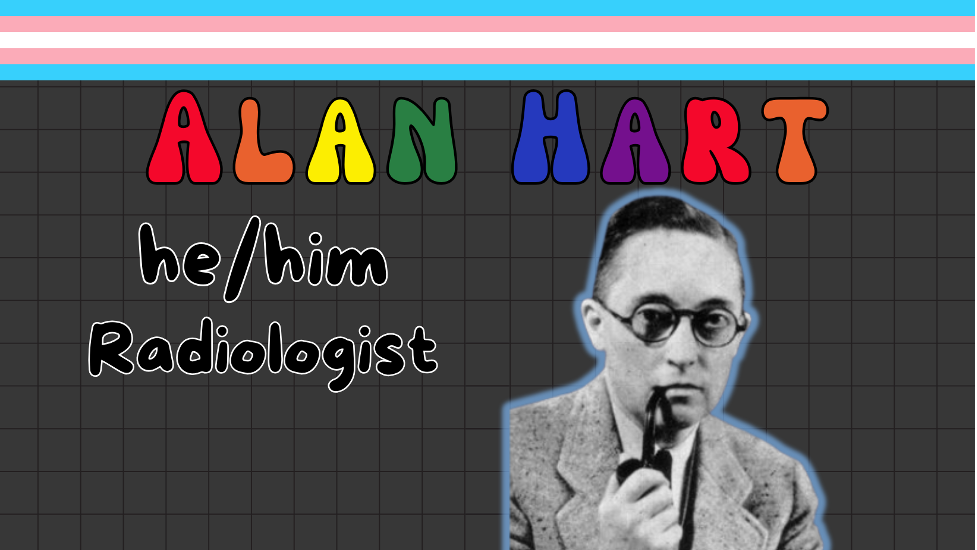
1912: Bachelor's degree (unspecified) from Albany College
1917: M.D. from the University of Oregon
Dr. Alan Hart was an American physician, radiologist, and tuberculosis researcher. When Hart was 2, his father died of typhoid fever, which led his mother to revert to her maiden name and move her family to Oregon. 3 years later, his mother married his step-father Bill Barton, and the family moved to his grandfather’s farm. Hart wrote later of his happiness during this time, when he was free to present himself masculinely, playing with boys' toys made for him by his grandfather. In his grandparents’ obituaries, Hart is even listed as their grandson. When Hart was 12 the family moved to Albany, where he was forced to present as female to attend school, but continued to spend the holidays at his grandfather's farm, presenting as a male among his friends. During his school years, Hart was allowed to write essays under his chosen name with little resistance, as it was fairly common practice at the time for females to use a pseudonym. Upon reaching adulthood, Hart sought psychiatric counseling and surgery to continue passing as a man, making him the first documented female-to-male transition in the US. After completing his medical degree, Hart was deeply upset by the issuance of his degrees in his dead name, as it would end up limiting his opportunities to use it in any future life under a male name. For a short amount of time post-graduation, he worked at a Red Cross hospital in Philadelphia while presenting as female. Hart spent much of his career researching tuberculosis (TB) and was one of the doctors who began to realize that myriad illnesses (consumption, white plague, etc.) were all instances of TB. Previously, doctors had already discovered that TB was an airborne disease, which meant it was preventable and treatable, but with no cure, the main hope they had for patients was early detection. In the early 20th century, X-ray was primarily used to detect tumors and bone fractures/breaks, but Hart became interested in its potential uses for TB detection. Hart’s interest in X-ray usage in this form proved incredibly useful for early detection and treatment. Even early X-ray machines could detect the disease before it became critical, which also allowed early treatment, often saving the patient's life. In 1917, Hart approached Dr. Joshua Gilbert, asking for surgical intervention to prevent menstruation and eliminate the possibility of pregnancy. While Gilbert hesitated at first, he eventually accepted that Hart was "extremely intelligent and not mentally ill, but afflicted with a mysterious disorder". After the surgery, Hart became one of the first trans men in US history to undergo a hysterectomy, and he then went on to legally change his name. Throughout his life, Hart also wrote short stories and novels, many of which feature semi-autobiographical elements. Sandy Farquhar, a character from one of his novels is short, thin, and bespectacled and considers himself "the possessor of a defective body" from which he wishes to escape, a possible expression of Hart’s gender dysphoria. Hart died on July 1, 1962, at the age of 71 from heart failure.

1983: B.S. in Physics from Harvey Mudd College
1988: M.S. in Engineering from California State University, Northridge on a Hughes Aircraft Fellowship
2001: M.B.A. from the University of Arizona on a Raytheon Fellowship
Amanda Simpson is an American engineer, businesswoman, pilot, and politician. Simpson currently works as an advisor and consultant on energy, aerospace, and DEI initiatives as the founder and CEO of Third Segment LLC. She is also well known for her public speaking, having presented at conferences, government agencies, colleges, and corporations around the US discussing aerospace and technology development and innovation and DEI topics such as gender and workplace equality. As a student at Harvey Mudd College, Simpson participated in the Bates Aeronautics Program, earning her single-engine land private pilot’s license in 1981. Simpson went on to become a Mission Director and Project Pilot beginning in 1988 before taking over as Director of Flight Operations in 1993 for the Integration, Test, and Analysis Laboratory at Hughes Missile Systems. As a Systems Test Pilot, she flew numerous test platforms in support of missile seeker technology development. After graduating in 1983, Simpson went on to work at Hughes Electron Dynamics Division as an Engineer and Program Manager. In 1988 she transferred to the Hughes Missile Systems Company where she became the Lead and Director of Flight Operations for the captive flight test activities; she later moved those operations to Tucson, where she consolidated the Hughes activities with the operations of General Dynamics, and later Raytheon. Simpson designed and oversaw the construction of an 80,000 sq. ft. dedicated flight test facility at the Tucson International Airport during this role. In 1999, Simpson went back to working as a Project Manager, this time working under Raytheon, Texas Instruments, and Standard Missile Company. Simpson occupied several systems engineer, systems architect, and systems integrator roles between 2002 and 2006 on various projects. Along with her work as an appointee by the Obama administration in the Bureau of Industry and Security, Simpson worked in the United States Department of Defense and was the first transgender person to lead a U.S. Department of Defense organization. Simpson served until the end of Obama’s presidency, as she was asked to resign along with nearly all other appointees from the Obama administration. Simpson is a fellow of the American Institute of Aeronautics and Astronautics and served on its Systems Engineering Technical Committee from 2007 to 2009. She is also a fellow of the Royal Aeronautical Society and serves on the board of directors of the Washington, D.C., branch. To date, Simpson has been recognized with over 20 different awards focused on diversity and innovation, as well as highlighting transgender and queer trailblazers.

1948: B.S. in Physics from Queens College, City University
1949: M.S. in Astronomy from Harvard University
1956: Ph.D. in Astronomy from Harvard University
Dr. Frank Kameny was an American astronomer and gay rights activist and is widely considered to be one of the most influential figures in the American gay movement. Born on May 21, 1925, to Ashkenazi Jewish parents in New York City, Kameny grew up feeling a deep love for science. He began his bachelor’s degree but was drafted to fight in World War 2 before he graduated, and later finished his degree upon return home. While on a trip to attend the meeting of the American Astronomical Society in San Francisco, Kameny was seen at a location labeled a hotspot for homosexual encounters. Two police officers were hiding in the terminal men's bathroom and witnessed Kameny and another man engaging in a sexual encounter. Kameny was detained and accused of "lewd and indecent acts", to which he was fined $55 and given 6 months probation. After the incident, Kameny relocated to Washington D.C., where he taught for a year at Georgetown University, then was hired by the US Army Map Service in July 1957. Once they learned of his San Francisco arrest, Kameny’s superiors repeatedly questioned him about the incident and his sexuality, to which Kameny refused to divulge any details. He was fired from the position soon afterward and was later barred from any future employment within the federal government. Kameny attempted to appeal his firing in court, losing twice before seeking review from the Supreme Court, which declined to hear the case. Kameny devoted himself to gay rights activism from then on, never working another traditional job again. In late 1961, Frank Kameny co-founded the Washington D.C. branch of the national gay rights organization, Mattachine Society which wrote letters to the entirety of Congress, as well as President Kennedy asking them to change the rules on homosexuals being kept from governmental positions. They argued that the government's discrimination based on sexuality is no different from discrimination based on race or religion. In 1963, Kameny and the Mattachine Society worked to overturn D.C.’s criminalization of sodomy, with Kameny himself drafting the bill that was later passed. Along with this, Kameny also worked closely with the American Psychological Association (APA) to remove the classification of homosexuality as a psychological disorder from the Diagnostic and Statistical Manual of Mental Disorders (DSM). In 1971, Kameny became the first openly gay candidate for the United States Congress, with his loss in the election leading him to form the Gay and Lesbian Alliance of Washington D.C., a group dedicated to lobbying for equal rights for queer people. Kameny’s work continued into the 2000s, as he continued to push for equality and spoke out against the erasure of queer suffering, as well as the widespread ignoring of the work of queer activists throughout history. Kameny suffered from heart disease in his later years but maintained a full schedule of public appearances. He passed away on October 11, 2011, in his home in Washington D.C.
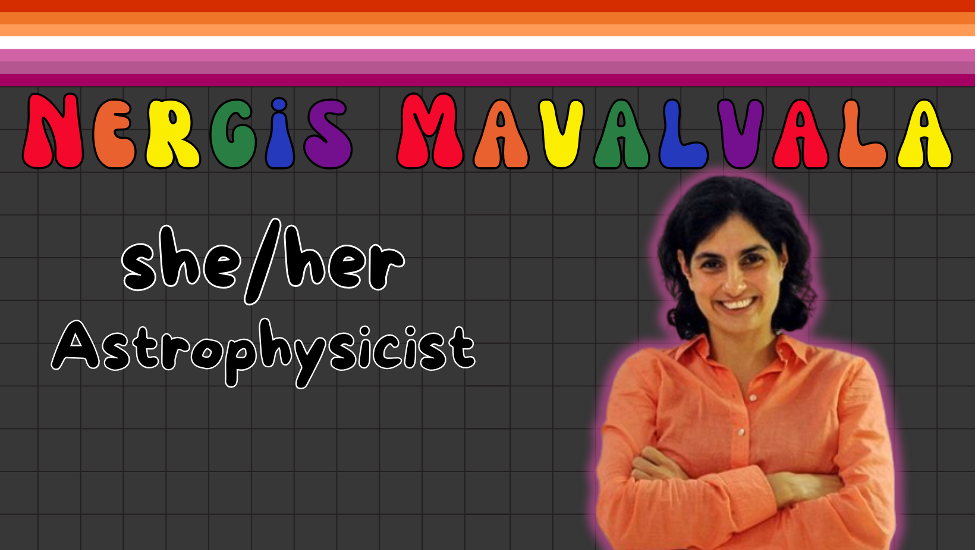
1990: B.S. in Physics & Astronomy from Wellesley College
1997: Ph.D. in Physics from MIT
Dr. Nergis Mavalvala is a Pakistani-American astrophysicist working as the Curtis and Kathleen Marble Professor of Astrophysics and Dean of the School of Science at MIT. Mavalvala was born in Lahore, Pakistan, but was primarily raised in Karachi, Pakistan. During her time working under Weiss at MIT, Mavalvala developed a prototype laser interferometer, a device for detecting gravitational waves. Mavalvala’s work focuses primarily on two subjects within the realm of physics: quantum measurement science and gravitational wave detection. She was one of the scientists on the team who, for the first time, observed ripples in the fabric of spacetime, also known as gravitational waves. She later began working as a postdoctoral researcher, and eventually a research scientist, at the California Institute of Technology, where she began studying cosmic microwave background. Another portion of Mavalvala’s work focuses on improving laser-cooling techniques, allowing for more precise cooling to eliminate measurement issues caused by thermal vibrations. She has conducted this work both for the Laser Interferometer Gravitational-Wave Observatory (LIGO) project, as well as other applications such as enabling the observation of quantum phenomena in macroscopic entities. These experiments are laying the groundwork for future ability to observe quantum phenomena in human-sized entities. Mavalvala has also worked on the development of exotic quantum states of light, and in particular the generation of light in squeezed coherent states. By injecting such states into the kilometer-sized Michelson Interferometer of the LIGO detectors, her team vastly improved the sensitivity of the detectors by reducing quantum noise, allowing for better detection results. Her team was also the first to generate squeezed light at room temperature through the use of optomechanics, compared to the previous instances that were generated at cryogenic temperatures. In 2017, she was elected to the National Academy of Sciences, a group that provides independent and objective advice on scientific matters to the government and the nation as a whole. Mavalvala identifies as a lesbian and is very public about her identity and the influences of being a queer, immigrant, person of color has had on her. She frequently discusses her lack of questioning her sexuality until after college, as well as her family’s lack of adherence to traditional gender roles, when discussing how her identity has shaped her career and personal outlook. Mavalvala is often seen as a role model for queer immigrant women, as well as young aspiring female scientists in the Indian subcontinent due to her achievements and persistence in staying true to her identity.

2021: B.S. in Marine Biology and Biological Oceanography
Jasmine Isa Qureshi is a queer English marine biologist, ecologist, activist, and writer. Some of their published pieces on topics such as conservation, diversity, trans and queer issues, Muslim identity, Islamophobia, climate change, and politics can be found in various publications like BBC Wildlife, Gaytimes, and the Metro. Her work as a writer and a speaker has also led her to curate and give workshops, seminars, and talks on subjects she has written about such as new understandings of queer thought and ecological studies. Qureshi has also worked as a researcher for several film production companies on natural history programs, such as BBC Natural History Unit, Wild Space Productions, Sound Off Films, etc., and has produced their own wildlife films. Currently, she is the Social Media Lead for the grassroots organization/collective Wildcard, working with the team to increase engagement and support for rewilding campaigns/projects within the UK. Alongside this, she is an Ambassador for the Bumblebee Conservation Trust and an Engagement Officer at the youth-led nature organization A Focus On Nature. Qureshi also sits on the Advisory Committee for RSPB England and is the founder of Soil To Sky, a grassroots think-tank/organization that seeks to better understand and teach ecology via the centering of trans and queer people of a global majority in nature/natural history. They have given workshops and presentations at various science festivals and other venues including the Cheltenham Science Festival, Edinburgh Science Festival, the University of Bristol, Harper Adams University, the University of Nottingham, Shambala Music Festival, and for the organization/collective Writing Our Legacy. As a wildlife/nature media presenter they have collaborated with the team behind BBC Springwatch, working with them to narrate a film on the Live YouTube Wildlife show, ‘8 Out of 10 Bats’, have worked with NatureCast (Edinburgh Science Festival), and VOX Media + Freeborne Impact (producing a film in collaboration with Attitude magazine on Ocean Conservation and ethical fashion).

2005: B.A. in Chemistry from the College of the Holy Cross
2011: Ph.D. in Chemistry from the University of Pennsylvania
2011-2012: Post-doctoral Researcher at the University of California, Berkeley
Dr. Andre Isaacs is a Jamaican chemist and professor at the College of the Holy Cross, his alma mater. Isaacs moved to the US to pursue higher education and regularly speaks of his uncle, who had taught chemistry and math but died young, as his inspiration in pursuing science education. As an undergraduate student, he conducted research in the labs of Dr. Kevin Quinn at the College of the Holy Cross. He was encouraged by his peers and professors to pursue graduate education due to his excellence in the area of organic chemistry. Under the guidance of Professor Jeffery Winkler at the University of Pennsylvania, Isaacs earned his Ph.D. in Chemistry and subsequently went on to work as a post-doctoral researcher at UC Berkeley. In 2012, he accepted a tenure-track position at the College of the Holy Cross, and in 2018, was promoted to the rank of Associate Professor with tenure. He is one of the co-founding members of Outfront - the college's LGBTQ faculty and staff alliance and serves as faculty advisor to several student groups including the Caribbean African Students' Assemblage, acapella group Fools on the Hill, and Club Tennis. Isaacs identifies as a queer Black immigrant in science and has used his experience to motivate his advocacy and encourage diversity in STEM through his social media presence. He has spoken openly about the challenges of being queer, black, and alienated, which nearly caused him to drop out of graduate school. Consequently, Isaacs has focused on community building when building his lessons and online presence.
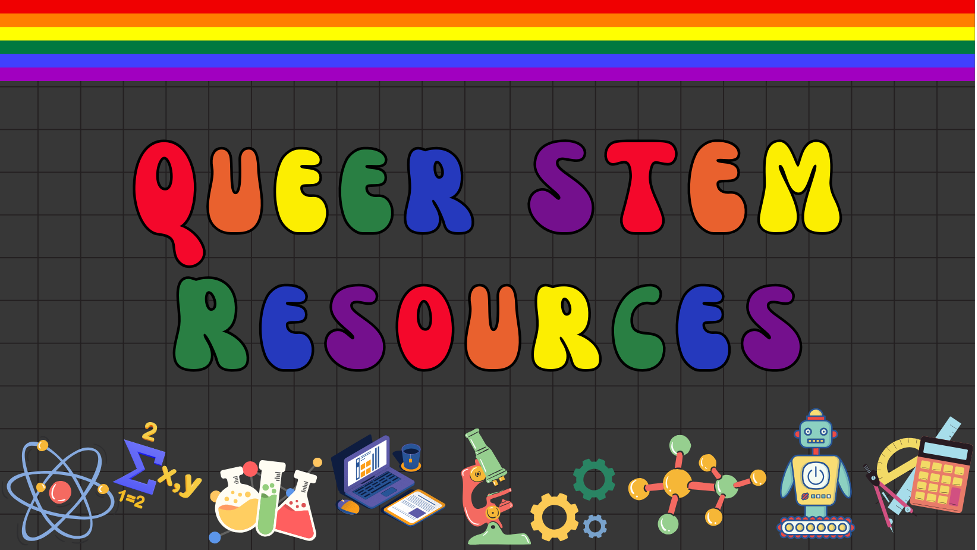
Queer representation in STEM is important for so many reasons. Younger generations can see themselves in the careers they aspire to have when people like them are visible in those roles. While it hasn’t always been easy to be out in the workplace, especially in STEM fields, things are slowly improving. Through the pioneers of the past and the persistent and visible representation of the present, queer people can find a piece of themselves in every career, company, and industry.
For more queer representation in STEM, we compiled a (noncomprehensive) list of some organizations, individuals, and social media accounts to look into!
Organizations:
- oSTEM
- Out to Innovate
- Pride in STEM
- 500 Queer Scientists
- NOGLSTP
- Out in Tech
- Unicorns in Tech
- LGBTQ in Technology
- PATHS
- Queers in Science
- Lesbians Who Tech
Individuals:
- Andre K. Isaacs @drdre4000 on Instagram, Tiktok, X/Twitter, and Youtube
- Mercury Stardust @mercurystardust on Tiktok and Youtube, and @mercurystardusttopz on Instagram
- Catriona Nguyen-Robertson @nyuroscientist on Instagram and Youtube and @drnyuroscientist on Tiktok
- Kyne @onlinekyne on Instagram, Tiktok, X/Twitter, and Youtube
- Leanne Pittsford @lepitts on Instagram and X/Twitter
Podcasts:
- Queer STEM History
- Queer Science!
- LGBTQ+ STEM Podcast (limited series)
- Getting Curious with Jonathan Van Ness
- Nature is Gay: Biology Beyond the Binary
